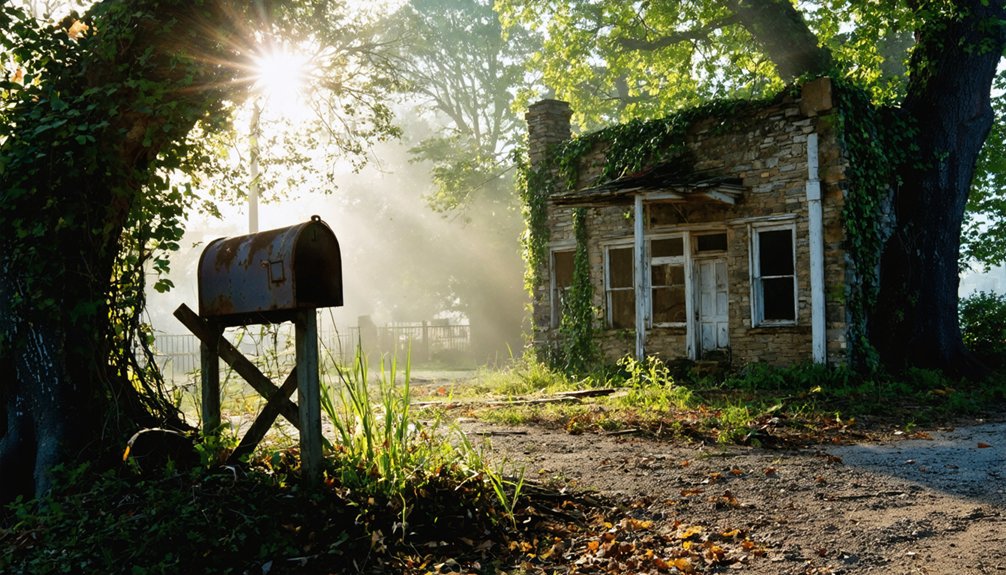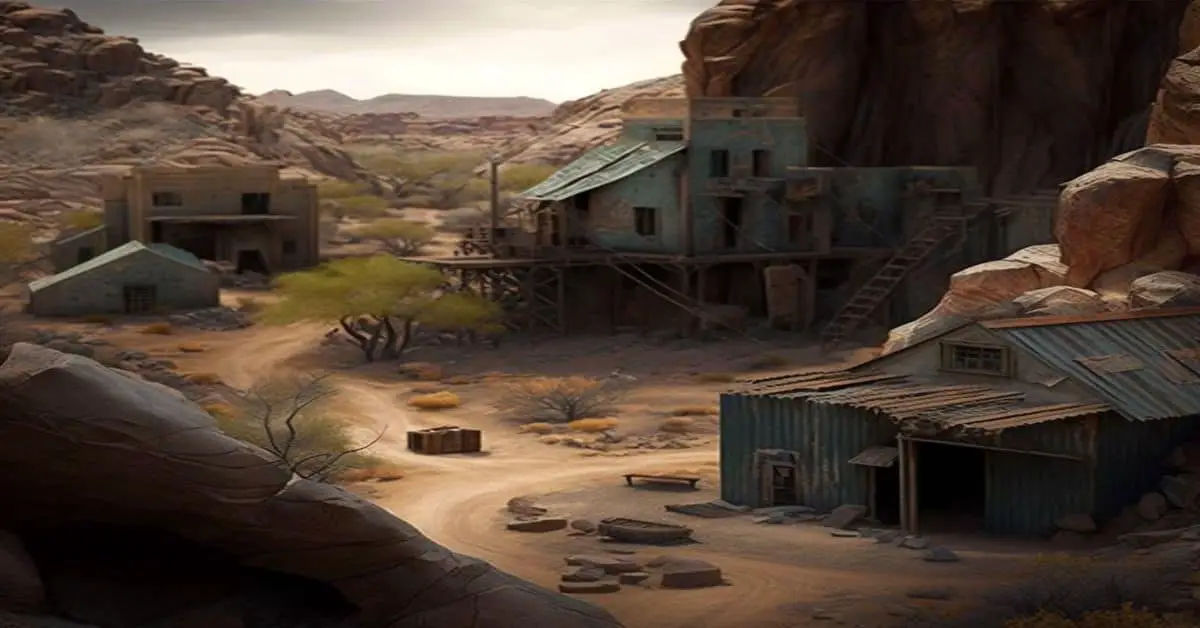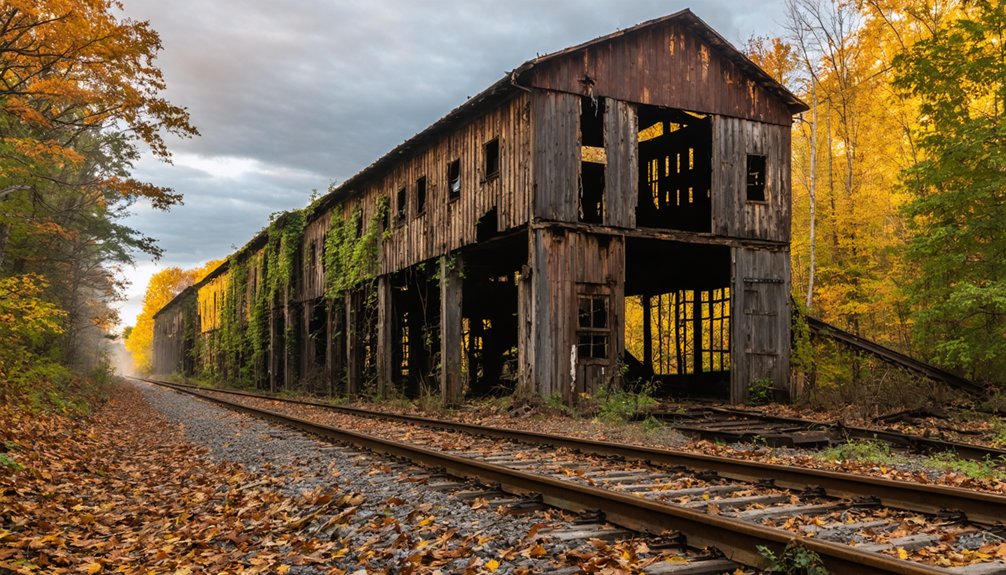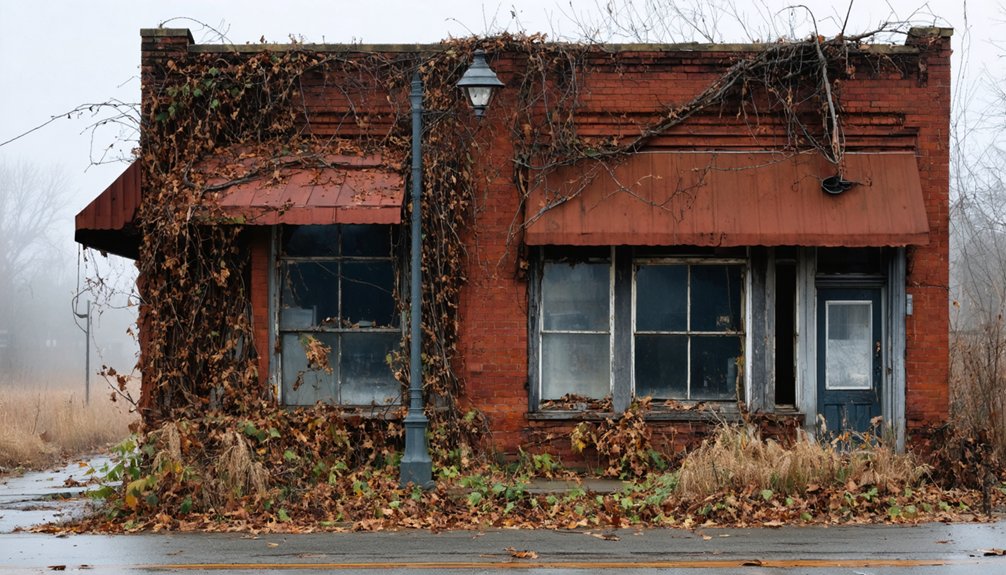You’ll find Elkinsville, Indiana’s haunting ghost town beneath Lake Monroe’s waters, where a thriving frontier settlement once stood from 1816 until the late 1950s. The U.S. Army Corps of Engineers forced nearly 100 residents to relocate when they flooded the valley for Bloomington’s reservoir. Today, you can visit the historic Elkinsville Bridge, scattered foundations, and the preserved cemetery, while annual reunions keep the town’s spirit alive. The mysteries of nearby Browning Mountain hold even darker secrets.
Key Takeaways
- Elkinsville was a thriving frontier settlement in Brown County, Indiana, established by William Elkins in the early 1800s near Salt Creek.
- The town became a ghost town when residents were forcibly relocated in the late 1950s for the Lake Monroe Reservoir project.
- Only scattered foundations, the Elkinsville Bridge, and one original inhabited building remain as physical evidence of the former community.
- The historic Elkinsville Cemetery contains nearly 150 gravestones and serves as a memorial to the displaced community.
- Annual reunions attract hundreds of former residents and descendants, preserving the memory of “The Town That Once Was.”
The Birth of a Frontier Settlement (1816)
As Indiana achieved statehood in 1816, pioneer William Elkins ventured into the untamed wilderness of what would later become Brown County, establishing a settlement in the fertile Salt Creek watershed.
You’ll find that Elkins chose this location wisely, recognizing the rich bottomlands that would support the agricultural practices needed for frontier survival.
The settlement quickly took shape as other pioneering families joined Elkins, facing the daily pioneer struggles of carving out a life in unmapped territory.
You can imagine the determination it took to build the first structures – farms, a church, and eventually a blacksmith shop and general store.
While spring flooding from Salt Creek posed challenges, the settlers adapted to the rhythm of the land, creating one of Brown County’s first permanent communities in an area that wouldn’t be officially mapped for another twenty years.
The settlers established what would become Elkinsville Cemetery, which still contains nearly 150 historic gravestone markers.
The community would continue to grow and thrive for over 140 years until the 1959 relocation forced residents to abandon their homes.
Life in the Salt Creek Valley Community
While Salt Creek Township wouldn’t be officially organized until 1825, life in the valley had already taken root through a network of Scots-Irish pioneer families who’d carved out their existence in the fertile bottomlands.
The community dynamics revolved around self-sufficiency and mutual support, with families like the Bohalls, Criders, and Deckards sharing resources and labor. The people who called this region home were predominantly of Scots-Irish descent, having migrated from Kentucky, Tennessee, and the Carolinas.
Early Salt Creek families wove tight bonds of cooperation, sharing both their daily work and precious resources to overcome frontier challenges.
Agricultural practices centered on general farming, where you’d find:
- Diverse crop cultivation for family sustenance
- Small-scale salt production from natural springs
- Home-grown food preservation and storage
- Informal bartering systems between neighbors
You’d discover a close-knit folk community where survival meant working together.
Despite recurring spring floods and geographic isolation, these hardy settlers maintained their independence through strong kinship ties and shared traditions, creating a resilient society that’d endure for generations. A traveling peddler would visit periodically, bringing essential goods to families who rarely made trips into town.
The Forced Exodus and Lake Monroe Project
During the late 1950s, the U.S. Army Corps of Engineers began acquiring land around Elkinsville, Indiana, forcing residents to abandon their homes for the Lake Monroe Reservoir project.
You’ll find that this forced relocation disrupted a century-old farming community of about 100 people who’d built their lives in the fertile Salt Creek Valley.
While officials cited Bloomington’s growing water needs and flood control as justification, the project devastated local families.
The community’s resilience showed as they faced losing ancestral lands, watching their homes get razed or moved.
Eight cemeteries required relocation, though Cutright Cemetery was never found.
The Army Corps documented that over 300 bodies were successfully relocated to other cemeteries.
Roads leading to Elkinsville were cut off, isolating what remained.
Though the town wasn’t submerged, the flooding transformed this once-vibrant community into little more than memories and a solitary cemetery above the waterline.
Bill Miller started a yearly reunion tradition in 1987 to help former residents maintain their connections to Elkinsville.
What Remains: Traces of a Lost Town
If you visit Elkinsville today, you’ll find the weathered Elkinsville Bridge and scattered building foundations serving as silent witnesses to the town’s past.
The community’s historic cemetery, established in 1830, remains an essential link to the original settlers, with headstones chronicling generations of local families. The area’s post office closed in 1941, marking the beginning of the town’s decline.
Bill Miller hosts annual reunions at his property, drawing former residents who gather to remember their shared history.
A 5-foot limestone and fieldstone memorial marker now stands at the town’s edge, commemorating the 18 families who were displaced by Lake Monroe’s creation.
Surviving Buildings Today
Today, only scattered traces remain of the once-vibrant Elkinsville community. When you explore the site now, you’ll find most surviving structures have been reclaimed by nature, with architectural remnants hidden beneath years of vegetation. The haunting Browning Hill area creates an unsettling atmosphere even in broad daylight.
Only Bill Miller still inhabits an original town building, while other structures were either moved or demolished during the reservoir’s development.
As you walk the grounds, you’ll discover:
- Exposed foundations and cellar holes scattered through forest clearings
- Old roadways that trace the town’s original layout
- Remnants of stone walls and property boundaries
- Post-1950s cabins and modified homes that replaced original structures
The Elkinsville Cemetery stands as one of the few intact historical landmarks from the original settlement. The site, now part of Hoosier National Forest, preserves a quieter way of life, where nature and history intertwine among the fading physical evidence of this former community.
Cemetery and Historical Marker
Among the most poignant remnants of Elkinsville’s past, the historic cemetery and limestone marker stand as enduring memorials to this displaced community.
You’ll find tombstones dating back to the 1800s, preserving the names of pioneer families who built this settlement from the ground up.
Near Browning Mountain, a 5-foot marker crafted from local limestone and fieldstone lists the names of displaced families – from Bohall to Wilkerson – who were forced to leave when Lake Monroe’s construction began.
The marker’s significance extends beyond mere commemoration, as it corrects the common misconception that Elkinsville lies underwater.
Together, these preserved sites serve as powerful touchstones of historical preservation, allowing you to connect with the spirit of a community that refused to be forgotten.
Stories and Legends From Elkinsville
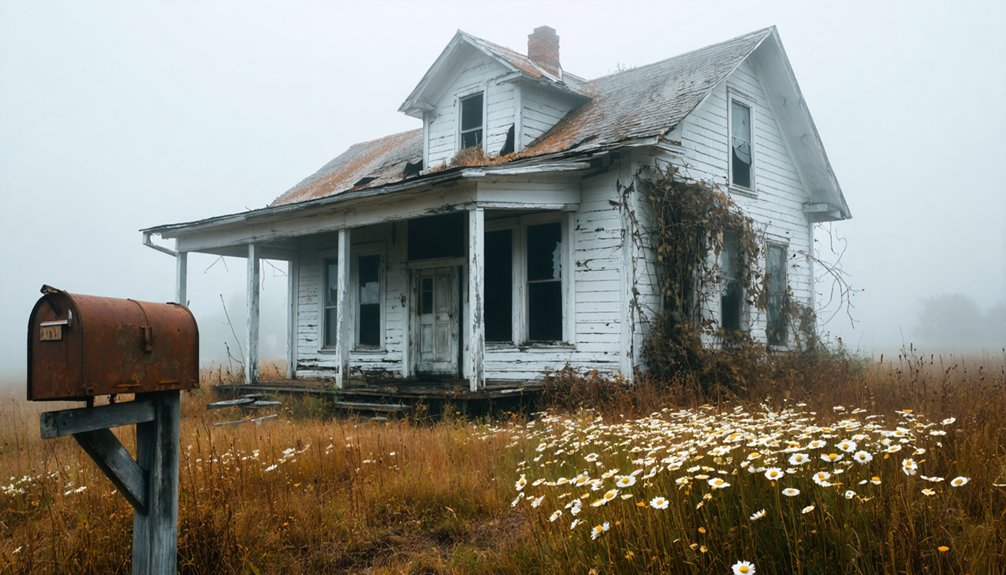
You’ll find the most chilling stories center around four distinct phenomena:
- Ghostly stonecutters roaming the hill at night
- Unexplained mechanical failures when attempting to move stones
- Fatal accidents befalling those who disturb the site
- Mysterious chain-snapping incidents during rock removal
What’s now called “Indiana’s Stonehenge” remains an enigma, with even South American archaeologists unable to determine if the formations are human-made or natural.
Indiana’s mysterious Stonehenge defies explanation, leaving experts puzzled over whether its enigmatic rock formations were shaped by human hands or nature itself.
Despite numerous investigations, you’ll discover that Browning Mountain fiercely guards its secrets, just as the legendary “keeper of the mountain” continues to protect this sacred ground.
Preserving the Legacy of “The Town That Once Was”
You’ll find that Elkinsville’s memory lives on through annual reunions started in 1987, where 250-300 former residents and their descendants gather to share stories and maintain their tight-knit community bonds.
The historic Elkinsville Cemetery, containing nearly 150 gravestone markers dating back to the mid-1800s, serves as a tangible link to the town’s past and remains carefully maintained by dedicated volunteers.
These preservation efforts, including both the social gatherings and the physical landmark of the cemetery, help guarantee that the spirit of “The Town That Once Was” continues to resonate with future generations.
Community Memory Through Reunions
The resilient spirit of Elkinsville lives on through annual community reunions that draw hundreds of former residents and their descendants. Through community storytelling and collective remembrance, you’ll find 250-300 people gathering to honor the town’s legacy beneath Browning Mountain, where their homes once stood.
These reunions preserve Elkinsville’s rich heritage through:
- Personal anecdotes and stories passed down through generations
- Local traditions and folklore that keep the town’s culture alive
- Tours of historical markers that commemorate displaced families
- Shared experiences that strengthen bonds among former residents
Rather than dwelling on the loss caused by Lake Monroe’s construction, you’ll discover how these gatherings focus on positive memories and the enduring community spirit that defines Elkinsville’s identity as “The Town That Once Was.”
Cemetery As Historical Landmark
Standing as one of the few remaining physical landmarks from the original town, Elkinsville Cemetery serves as a poignant tribute to the community’s enduring legacy.
You’ll find nearly 150 gravestones dating back to the mid-1800s, telling stories of the area’s earliest settlers, including founder William Elkins from 1816.
The cemetery’s historical significance extends beyond its role as a final resting place. It’s now an essential stop on historical tours, featuring a granite marker that honors families displaced by the Lake Monroe Reservoir project.
Through volunteer-maintained amenities like picnic areas and restrooms, you’ll experience a well-preserved piece of local heritage.
While most of Elkinsville’s original structures succumbed to the reservoir’s development, the cemetery stands as a monument to the community’s resilience and determination to preserve their history.
Frequently Asked Questions
How Deep Is Lake Monroe Where Elkinsville Once Stood?
You’ll find that historic Elkinsville wasn’t actually submerged – a surprising twist in lake planning. The lake’s depth there is minimal, as the town’s location remained above Lake Monroe’s water level.
Are There Any Original Elkinsville Residents Still Alive Today?
While remaining descendants gather for reunions, historical records indicate it’s unlikely any original residents survive today, as they’d be well into their 80s or older by 2025.
Can Visitors Legally Explore the Remaining Structures in Elkinsville?
You can’t legally enter most remaining structures due to ghost town laws protecting private property. Your safest exploration options are the cemetery and viewing ruins from public roads.
What Happened to the Businesses and Church Buildings After Displacement?
You won’t find any business repurposing or historical preservation efforts – the Army Corps of Engineers demolished all businesses and church buildings during the 1964 land acquisition for Lake Monroe Reservoir construction.
Did Any Residents Refuse to Leave During the Forced Evacuation?
You’ll find resistance stories of about 15 residents who initially refused to leave their homes, staying behind despite the forced evacuation. The emotional impact drove most to eventually relocate as isolation grew.
References
- https://www.youtube.com/watch?v=M-ny30XuAE8
- https://www.onlyinyourstate.com/trip-ideas/indiana/autumn-day-ghost-town-in
- https://www.indystar.com/story/news/history/2019/10/25/indianas-ghost-towns-phantoms-past/3907908002/
- https://www.youtube.com/watch?v=FeqM-1mmwl4
- https://www.heraldtimesonline.com/story/lifestyle/home-garden/2021/02/26/ours-share-history-of-elkinsville-the-town-that-was/44018517/
- https://lostinthestates.com/a-tombstone-for-a-town/
- https://www.bloomingpedia.org/wiki/Elkinsville
- https://en.wikipedia.org/wiki/Elkinsville
- https://ourbrowncounty.com/2012-march-april/lost-history-of-brown-county/
- https://www.hoosierhistorylive.org/archives-2008.html
